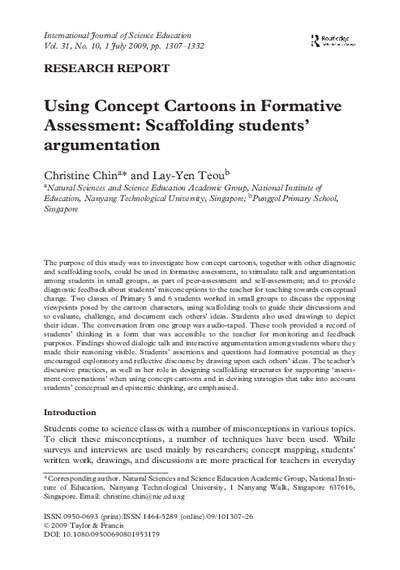Using Concept Cartoons in Formative AssessmentScaffolding students’ argumentation
Christine Chin, Lay‐Yen Teou
Publikationsdatum:
|
 |
 Diese Seite wurde seit 3 Jahren inhaltlich nicht mehr aktualisiert.
Unter Umständen ist sie nicht mehr aktuell.
Diese Seite wurde seit 3 Jahren inhaltlich nicht mehr aktualisiert.
Unter Umständen ist sie nicht mehr aktuell.
 Zusammenfassungen
Zusammenfassungen
In view of the potential afforded by concept cartoons as both a formative
assessment and learning tool, this study was carried out where a teacher
attempted to engage her students in thinking and arguing about selected science
concepts using concept cartoons, with the aim of diagnosing their misconceptions and
designing learning interactions to engender conceptual change.
Von Christine Chin, Lay‐Yen Teou im Text Using Concept Cartoons in Formative Assessment (2009) The purpose of this study was to investigate how concept cartoons, together with other diagnostic
and scaffolding tools, could be used in formative assessment, to stimulate talk and argumentation
among students in small groups, as part of peer-assessment and self-assessment; and to provide
diagnostic feedback about students’ misconceptions to the teacher for teaching towards conceptual
change. Two classes of Primary 5 and 6 students worked in small groups to discuss the opposing
viewpoints posed by the cartoon characters, using scaffolding tools to guide their discussions and
to evaluate, challenge, and document each others’ ideas. Students also used drawings to depict
their ideas. The conversation from one group was audio-taped. These tools provided a record of
students’ thinking in a form that was accessible to the teacher for monitoring and feedback
purposes. Findings showed dialogic talk and interactive argumentation among students where they
made their reasoning visible. Students’ assertions and questions had formative potential as they
encouraged exploratory and reflective discourse by drawing upon each others’ ideas. The teacher’s
discursive practices, as well as her role in designing scaffolding structures for supporting ‘assessment
conversations’ when using concept cartoons and in devising strategies that take into account
students’ conceptual and epistemic thinking, are emphasised.
Von Christine Chin, Lay‐Yen Teou im Text Using Concept Cartoons in Formative Assessment (2009)  Dieser wissenschaftliche Zeitschriftenartikel erwähnt ...
Dieser wissenschaftliche Zeitschriftenartikel erwähnt ...
 Personen KB IB clear | Brenda Keogh , Stuart Naylor | ||||||||||||||||||
 Begriffe KB IB clear | Argumentieren
,  concept cartoons
, concept cartoons
,  Denken Denken thinking
, Fehlvorstellungen / misconceptions
, formative Beurteilung
, thinking
, Fehlvorstellungen / misconceptions
, formative Beurteilung
,  LehrerIn LehrerIn teacher teacher
| ||||||||||||||||||
 Texte |
|
 Dieser wissenschaftliche Zeitschriftenartikel erwähnt vermutlich nicht ...
Dieser wissenschaftliche Zeitschriftenartikel erwähnt vermutlich nicht ... 
 Nicht erwähnte Begriffe | Fehlvorstellungen beim Programmieren, Schule, summative Beurteilung, Unterricht |
 Zitationsgraph
Zitationsgraph
 Zitationsgraph (Beta-Test mit vis.js)
Zitationsgraph (Beta-Test mit vis.js)
 2 Erwähnungen
2 Erwähnungen 
- What Makes Concept Cartoons More Effective? - Using Research to Inform Practice (Filiz Kabapinar) (2009)


- Concept Cartoons: What Have We Learnt? (Stuart Naylor, Brenda Keogh) (2012)


 Anderswo finden
Anderswo finden
 Volltext dieses Dokuments
Volltext dieses Dokuments
 |  Using Concept Cartoons in Formative Assessment: Artikel als Volltext ( Using Concept Cartoons in Formative Assessment: Artikel als Volltext ( : :  , 541 kByte; , 541 kByte;  : :  ) ) |
 Anderswo suchen
Anderswo suchen 
 Beat und dieser wissenschaftliche Zeitschriftenartikel
Beat und dieser wissenschaftliche Zeitschriftenartikel
Beat hat Dieser wissenschaftliche Zeitschriftenartikel während seiner Zeit am Institut für Medien und Schule (IMS) ins Biblionetz aufgenommen. Beat besitzt kein physisches, aber ein digitales Exemplar. Eine digitale Version ist auf dem Internet verfügbar (s.o.). Aufgrund der wenigen Einträge im Biblionetz scheint er es nicht wirklich gelesen zu haben. Es gibt bisher auch nur wenige Objekte im Biblionetz, die dieses Werk zitieren.










 Biblionetz-History
Biblionetz-History